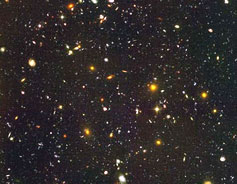
Handy Links
SLAC News Center
SLAC Today
- Subscribe
- Archives: Feb 2006-May 20, 2011
- Archives: May 23, 2011 and later
- Submit Feedback or Story Ideas
- About SLAC Today
SLAC News
Lab News
- Interactions
- Lightsources.org
- ILC NewsLine
- Int'l Science Grid This Week
- Fermilab Today
- Berkeley Lab News
- @brookhaven TODAY
- DOE Pulse
- CERN Courier
- DESY inForm
- US / LHC
SLAC Links
- Emergency
- Safety
- Policy Repository
- Site Entry Form

- Site Maps
- M & O Review
- Computing Status & Calendar
- SLAC Colloquium
- SLACspeak
- SLACspace
- SLAC Logo
- Café Menu
- Flea Market
- Web E-mail
- Marguerite Shuttle
- Discount Commuter Passes
-
Award Reporting Form
- SPIRES
- SciDoc
- Activity Groups
- Library
Stanford
Around the Bay
Dark Matter Burners
 Like fishermen of the deep universe, population III stars cast their nets into a sea of dark matter and catch weakly interacting massive particles (WIMPS) to live on. Researchers at the Kavli Institute for Particle Astrophysics and Cosmology (KIPAC) at SLAC are exploring the life and evolution of these stars and have released their work in a paper that recently
appeared on arXiv. The researchers found that these dark matter burning stars contributed to a great change in the universe in a different way than their non-dark matter burning relatives.
Like fishermen of the deep universe, population III stars cast their nets into a sea of dark matter and catch weakly interacting massive particles (WIMPS) to live on. Researchers at the Kavli Institute for Particle Astrophysics and Cosmology (KIPAC) at SLAC are exploring the life and evolution of these stars and have released their work in a paper that recently
appeared on arXiv. The researchers found that these dark matter burning stars contributed to a great change in the universe in a different way than their non-dark matter burning relatives.
Ancient population III stars may have captured dark matter and "burned" it as fuel. WIMPS—the prime particle candidates for dark matter—scatter off of the gas particles of a star, causing them to sink to the center, where they release energy. This energy can partly or completely replace the fusion that normally burns inside the star. The particles that the WIMPS scatter off of and the radius of the star create a cross section like the knots in a net: if the knots are too far apart, the dark matter particles will slip through. But a small enough cross section weaves a net that scoops up WIMPS to fuel the star for orders of magnitude longer than it would otherwise live.
Of course there must also be plenty of fish in the sea: the star must live inside a dense halo of dark matter. Lower densities of dark matter could result in a star only partially replacing fusion with dark matter burning. Population III stars formed in the early universe when dark matter densities were higher than today, but they formed so early that, if they didn't burn dark matter, they should have all died out long ago. Yet if any of them caught enough dark matter to fuel them, they might still be alive, but would be difficult to detect from Earth.
The paper, authored by Sung-Chul Yoon of U.C. Santa Cruz, Fabio Iocco of Italy's INAF and Shizuka Akiyama of KIPAC, calculates quantitative values for the ionizing photons emitted by these dark matter burning stars, and compares it to that of non-dark matter burning stars. Ionizing photons are unique bundles of light that hold enough energy to separate the proton and electron of a neutral hydrogen atom—the most abundant element in the universe. Between 150 million and one billion years after the Big Bang, there began a massive separation of neutral hydrogen atoms into disconnected electrons and protons. As a result of reionization, our universe looks mostly translucent: we can point our telescopes in any direction and see objects far away. Because the hydrogen atoms are ionized, the separated protons and electrons cannot capture photons, allowing the light from distant stars to travel all the way to Earth unimpeded.
How and why this universal reionization process occurred is of great interest to astronomers, who are searching for sources of ionizing photons. This new paper examines the differences in the number of ionizing photons contributed by dark matter burning stars versus their non-dark matter relatives. Population III stars that run entirely on dark matter burning emit fewer ionizing photons than regular stars, even with their long lifetimes. But this new research suggests that a star supported only partially by dark matter burning could actually contribute more. These partial dark matter burning stars (created by a lower dark matter density surrounding them) emit photons because they are hot from partial fusion burning, yet by burning some dark matter they live longer than normal stars. Akiyama says this result is not intuitive, and that one might simply assume that a higher dark matter density around the star would lead to higher ionizing photon levels.
This new paper is one of many in a growing pool of information on dark matter burning stars. Akiyama is excited about the future of the subject. "The topic is extremely young, so there are a lot of things to be explored," she says. "The effects of dark matter burnings have already been studied for compact objects and zero age main sequence low-mass stars. The application to population III stars is very exciting because it is expected that they were influential in the early universe in different ways."
—Calla Cofield, SLAC Today, July 15, 2008